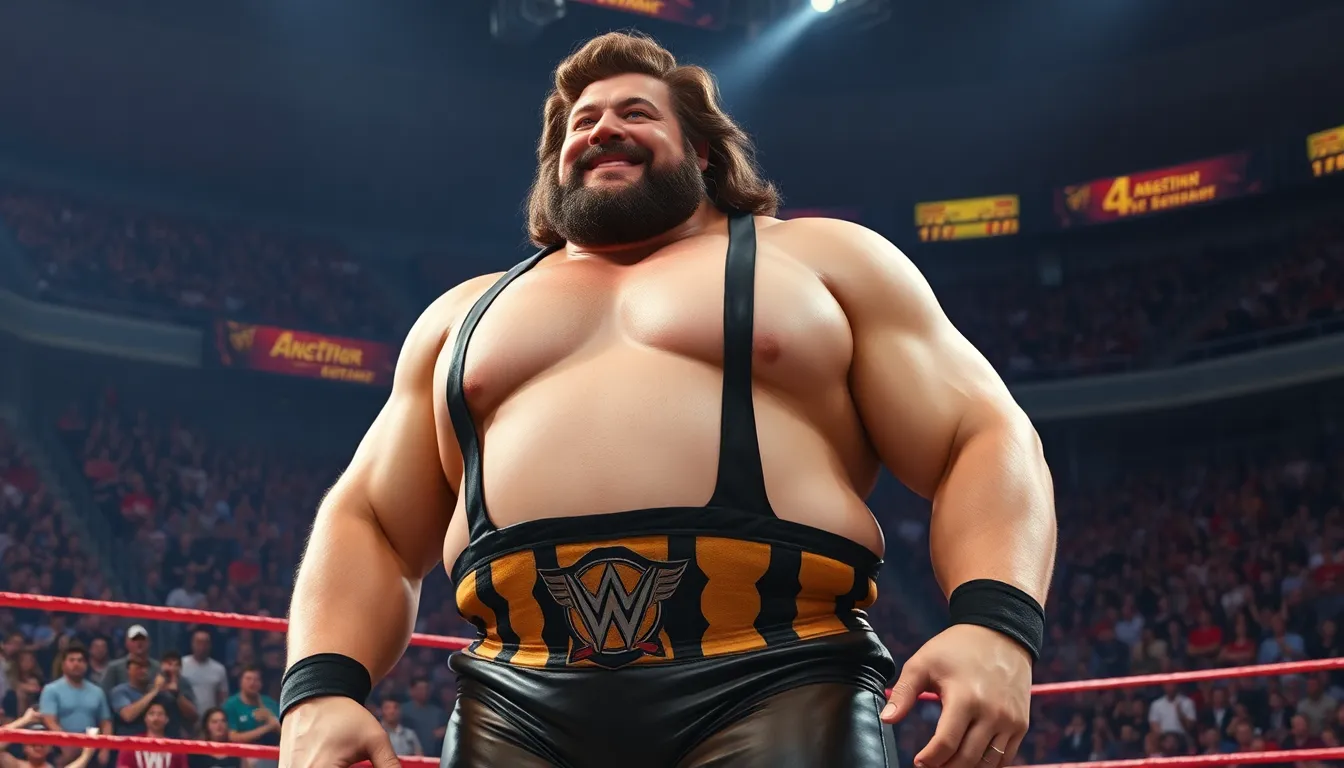Table of Contents
ToggleAndré the Giant, a legendary figure in professional wrestling and film, captivated audiences with his immense size and charisma. Known for his larger-than-life persona, he became an icon both inside and outside the ring. However, behind the fame lay a complex life marked by health challenges that ultimately led to his untimely death.
As fans continue to celebrate his legacy, questions about the cause of his passing remain. André’s health issues were closely tied to acromegaly, a disorder caused by excess growth hormone. This condition not only contributed to his towering stature but also to various health complications. Understanding the factors that led to his death sheds light on the struggles he faced, revealing the man behind the myth.
Overview of Andre The Giant
André the Giant, born André René Roussimoff on May 19, 1946, in Grenoble, France, gained fame as a wrestler and actor. He stood at 7 feet 4 inches tall and weighed over 500 pounds, which made him a unique figure in the entertainment industry. His notable presence captured the attention of wrestling fans and moviegoers alike.
He began his wrestling career in the late 1960s, quickly becoming a fierce competitor in various promotions. He was known for his larger-than-life personality and strength, showcasing his skills in iconic matches against opponents like Hulk Hogan and Randy Savage. Additionally, he appeared in films such as “The Princess Bride,” where his role as Fezzik showcased his charm and comedic talent.
Acromegaly, a disorder resulting from excess growth hormone, significantly impacted André’s health and physicality. The condition led to the growth of his hands, feet, and facial features, creating both challenges and opportunities throughout his life. His health deteriorated over the years, culminating in various related issues that affected his mobility and overall well-being.
André’s legacy continues to thrive through his contributions to wrestling and film. He remains an enduring symbol of strength and charisma, celebrated by fans worldwide for his impact on the industry and popular culture.
Life and Career Highlights

André the Giant’s life and career were marked by remarkable achievements and challenges that defined him as a legendary figure. From his early beginnings to his iconic roles in wrestling and film, his story captures the essence of his larger-than-life persona.
Early Life
André René Roussimoff was born on May 19, 1946, in Grenoble, France. Growing up in a rural area, he faced significant challenges due to acromegaly. This disorder resulted in accelerated growth, leading to his extraordinary height of 7 feet 4 inches. As a teenager, he worked on his family’s farm while participating in local rugby games. By 17, his unique stature caught the attention of a wrestling promoter, launching his path toward professional wrestling.
Wrestling Career
André’s wrestling career began in the 1960s, quickly earning notoriety for his size and strength. He became a central figure in many wrestling promotions, including the World Wrestling Federation (WWF). Notable matches included iconic bouts against champions like Hulk Hogan and Randy Savage. His legendary feud with Hogan culminated in a record-breaking main event at WrestleMania III in 1987, where he faced Hogan in front of 93,173 fans. Throughout his wrestling career, he garnered a loyal fanbase, becoming synonymous with the sport.
Film Appearances
In addition to wrestling, André appeared in various film productions. His most celebrated role came in 1987 as Fezzik in the classic film “The Princess Bride.” This role showcased his acting abilities and comedic timing, endearing him to a broader audience beyond the wrestling world. André’s presence transcended both industries, and he became an unforgettable character in popular culture. Other notable appearances included roles in films such as “The Greatest American Hero” and “The Fall Guy,” further solidifying his status as a versatile entertainer.
Health Issues
André the Giant faced significant health challenges throughout his life, largely due to acromegaly, a disorder characterized by excess growth hormone. This condition severely impacted his overall health and mobility.
Known Medical Conditions
André’s acromegaly led to numerous medical complications. Notable conditions included:
- Heart Disease: Enlargement of the heart muscle increased the risk of cardiovascular problems.
- Joint Pain: His massive frame caused chronic pain, particularly in the joints and back.
- Gastrointestinal Issues: André experienced persistent digestive problems, exacerbating his discomfort.
These conditions collectively affected his quality of life, contributing to his declining health in later years.
Impact on His Career
André’s health issues influenced his wrestling career. While his size and strength brought immense popularity, the physical toll of his conditions limited his ability to perform consistently. He faced mobility challenges that required him to reduce his match schedule over time. Despite this, he remained a beloved figure, captivating audiences with his unique demeanor and charisma. His eventual retirement from wrestling stemmed not just from age but also from the increasing demands of his deteriorating health.
Circumstances Surrounding His Death
André the Giant’s death on January 27, 1993, occurred under somber circumstances that reflected his lengthy battle with health issues. Complications stemming from acromegaly significantly impacted his final days.
Final Days
André’s final days showcased a marked decline in his health. By the early 1990s, he experienced increased difficulty with mobility, significantly affecting his quality of life. He spent much of his time in a rented room in a hotel near his wrestling engagements. Despite these challenges, he remained dedicated to his fans, often participating in personal appearances to connect with them. Close friends noted his struggles, emphasizing the toll of his health issues on his once vibrant persona.
Medical Examinations
Medical examinations conducted during André’s life revealed critical insights into his deteriorating condition. Physicians confirmed that acromegaly had led to severe complications, including heart disease. He faced consistent gastrointestinal problems, exacerbated by his massive size. An autopsy revealed that André suffered from congestive heart failure, a consequence of years of health decline. These examinations underscored the impact of his medical conditions, providing a clearer picture of the factors contributing to his untimely death.
Public Reaction and Legacy
André the Giant’s death prompted a profound reaction from fans and fellow wrestlers alike. Tributes poured in from the wrestling community, highlighting his larger-than-life persona and contributions to the sport. Prominent figures, such as Vince McMahon and Hulk Hogan, expressed their admiration for André’s talent and his impact on professional wrestling. Fans remembered him for his kindness and generosity, sharing stories of personal encounters that showcased his humility despite his fame.
His legacy transcends the wrestling ring, influencing generations of wrestlers and entertainers. The documentary “André the Giant,” produced by HBO, further solidified his status as a cultural icon, detailing his life story and enduring impact on the industry. Additionally, André’s portrayal in “The Princess Bride” continues to resonate with audiences, earning him a place in cinematic history.
André the Giant’s contributions to wrestling led to the establishment of various honors, including the WWE Hall of Fame induction in 1993, shortly after his passing. His character remains a powerful symbol of perseverance against adversity and the celebration of individuality in sports and entertainment. Fans and wrestlers celebrate his legacy through annual events and merchandise, ensuring that his memory endures in the hearts of many.
André the Giant’s legacy continues to resonate with fans and wrestlers alike, marking him as an unforgettable figure in both wrestling and film. His larger-than-life persona and remarkable talent left an indelible mark on popular culture. Despite the health challenges he faced throughout his life, André’s spirit and dedication to his craft shone through.
His passing in 1993 was a significant loss to the entertainment world, yet his influence remains strong. The tributes from fans and colleagues highlight the profound impact he had on those around him. André’s story serves as a testament to resilience and the celebration of uniqueness, ensuring that his memory will live on for generations to come.






